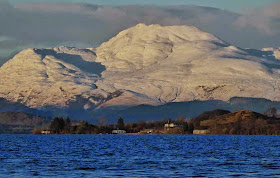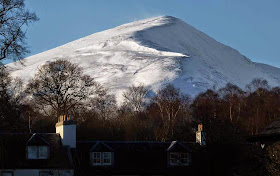A Saturday trip up north this time saw myself, Alex, Graeme, Grant and David head up as a carload of hill walkers to the Graham just south of Aberfeldy, Meall Dearg, 690 metres or 2263 feet, and its outlying top Creag an Loch, 663 metres. The snow was deep and crisp and uneven up here with a forecast of clear skies but a windchill factor of -20 below on the heights, once on the snowfields. About a 20 miles an hour wind blowing steadily in exposed places so we had full thermal gear on all day. Graham: a Scottish mountain between 2000 and 2500 feet high.
The track in was sheet ice covered in a few inches of snow, where I managed to do the full banana skin fall, heels in the air, landing flat on my back on the ice. Luckily, my rucksack took most of the impact but it was a sore one. Saved the camera as I had it out at the time but a keen photographer never drops his guard.... or grip:o) These hills and this high upland road through Glen Cochill (A826) seems to be a popular skiing destination in winter as a few other cars with cross country skiers arrived to take advantage of the network of forestry and upland tracks leading onto the surrounding mountains. We parked near Loch na Craige to take advantage of a track through the forest leading towards our hill.
Away from the track, see photo above, snow covered the landscape, where deep hidden holes lurked to trap the unwary. Graeme sinking up to his thigh in this one. At least it was a dry hollow.
Falling into this other one would be like dropping into a waist deep, half frozen, slush puppy. Not pleasant and potentially dangerous at the start of the day.
As we climbed higher onto the plateau the frozen snow held our weight more often and we didn't crash through it so much, which can be very draining, energy wise. Scotland lies at the same latitude as parts of Alaska and Hudson Bay in Canada and away from the effects of the coast and Gulf Stream temperatures the weather conditions can be brutal. Low winter sunlight didn't provide much heat and you wouldn't last long up here in the event of an accident. Every time I took my gloves off to take a quick photograph it took at least ten minutes to heat them back up again.
Nice wind blown snow patterns in this shallow gully filled with deeper waist high drifts. The secret is to avoid these areas altogether and walk up the firm ridges and sections where the snow will take your weight. Easier said than done in some cases.
Avoiding frozen bodies of water is also advisable as many folk have crashed through into snow covered lochans in the past during white out conditions and not even realized they had water beneath their boots. A lot of ancient "Coffin Roads" lost a body or two and some of the bearers this way giving you an idea of how brutal life was in the Scotland of old. Wolves were feared and hated then mainly because they dug up fresh bodies and left them for scavengers after they had eaten their fill so clans often buried their dead on islands in lochs to avoid this fate and would travel miles carrying coffins over the hill passes to do so. Loch Fender, seen here, with mini ice bergs in it, still half frozen.
Very interesting article here on the last of the roaming wolf packs in Scotland, the demise of the great wood of Caledon that stopped the Roman Army in its tracks and the gradual change to the desolate barren wasteland we think of as "natural Scottish wilderness" today. Only a lonely handful of ancient yew trees scattered in otherwise bleak, empty glens are old enough to "remember" the lynx, the brown bear, the wild boar, the elk and the wolf running or sheltering under their branches.
http://www.wolvesandhumans.org/wolves/history_of_wolves_in_scotland.htm
Graeme and David with what looks like Schiehallion, a popular Munro at 1083 metres, looming in the background. Several large wind farms now ring this empty quarter but one in particular annoyed me as it stood in the way of superb wild views to the Northern Munros. The Beinn a Ghlo range and several others in the distance.
I've always suspected large wind farms are just another license to print money and a tax dodge, like the blanket forestry plantations over the flow country or the shares issue, both several decades ago. If they are, doubtless the tax payer will pick up the bill to remove them ... or even worse... they prove too costly to remove and we are stuck with them forever, once they break down, as permanent eyesores in the environment. I,m not scientific enough to know the full truth of whether we require them or not... few are outside of the scientific community itself. Here's an interesting short link however with a few details folk might not be aware of about "Harmless Green Energy."
http://www.scotsman.com/news/comment-renewables-drain-our-resources-1-3659067
It's a complicated topic with strong opinions on all sides and hard for any non academic to understand. Personally, I don't mind them in bleak, desolate areas that are scenically uninteresting anyway, or land covered in man made blanket conifer plantations already devoid of most forms of wildlife. However, most of these obvious areas have been grabbed by turbines already so they are now starting to intrude on the types of landscapes that tourists and UK visitors pay good money to see.
http://www.scotsman.com/news/environment/rspb-lodges-legal-challenge-against-wind-farms-1-3659114?WT.mc_id=Outbrain_text&obref
If they are not harmful to birds flying into the blades in poor visibility... why the legal challenge?
From my own point of view, as a frequent hill walker around Scotland, mainly south of Glencoe (Truth is, I cant afford the petrol these days to go further north in my own country :o) there are very few occasions now when wind farms do not spoil the view, often in two directions at once. It's getting increasingly harder to take a photograph showing Scotland's beauty without a wind farm in the picture somewhere.
http://www.scotsman.com/news/environment/wind-turbines-ruin-views-in-most-of-scotland-1-3540530
Three short articles from one newspaper in the space of a five minute search under "Scottish wind farms" so people are increasingly concerned over this issue. Given the speed of construction and the sheer number of applications (which is why I suspect a rat regarding value for money over the long term) it may already be too late.
Nearing the summit slopes of Meall Dearg after a canter across the windswept upland plateau. Brutal winds and freezing conditions meant we were all glad we had avoided the higher Munro summits today.
Getting there....
Coming back down, descending icy slopes.
Canter out to the road and looking forward to being warm again.
A last hurdle. As we came down by a circular route we had a burn to cross at the end. Far better to have wet feet at the end of the day rather than at the start. A grand energetic outing. Winter has definitely arrived in Scotland.
Still continuing the traditional folk music theme here's a suitable video. In the 1980s I was a big fan of east coast social rebel Dick Gaughan, went through to see him perform in Edinburgh pubs and venues, and still have all his early albums. Powerful singer and magical guitar player. This is from his classic Handful of Earth album. LP of the year way back in 1981. My own favourite though is his first album from the early 1970s No More Forever, which is less political, just full of great traditional folk songs.






























































